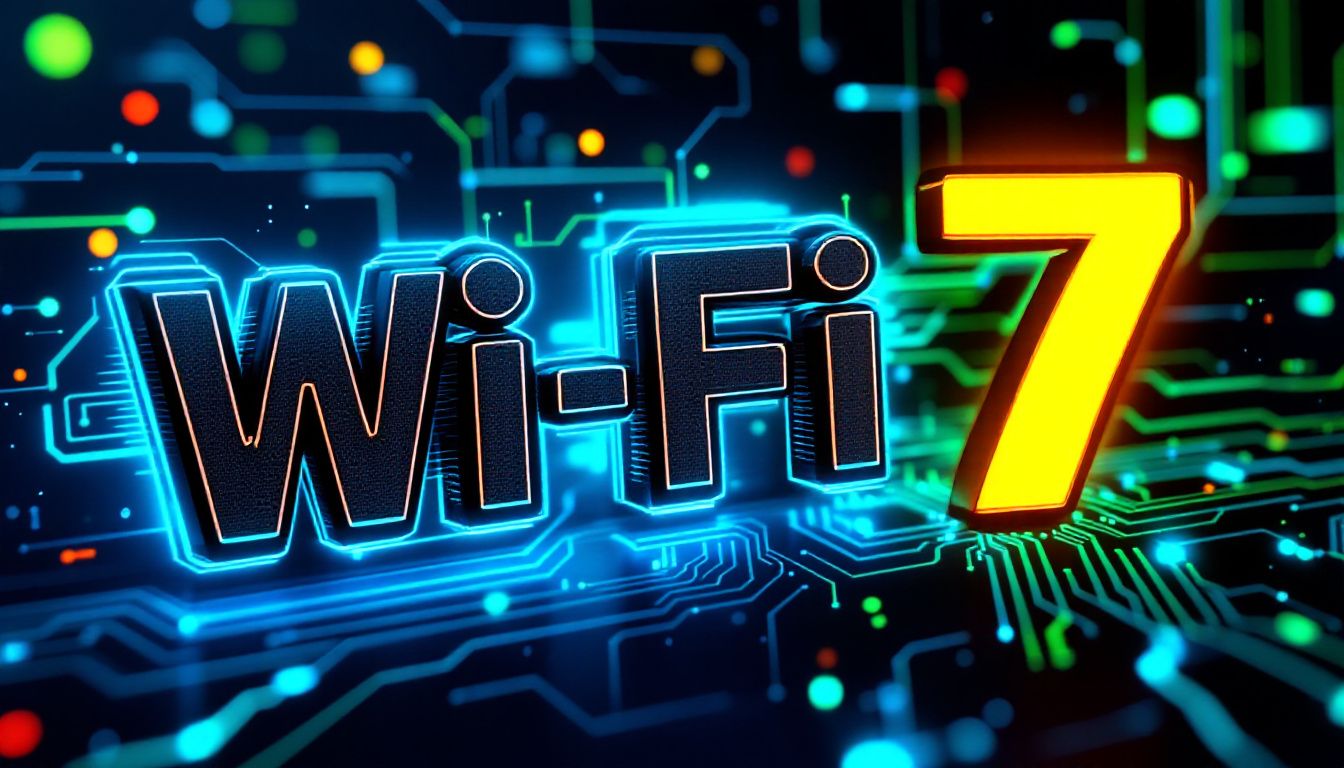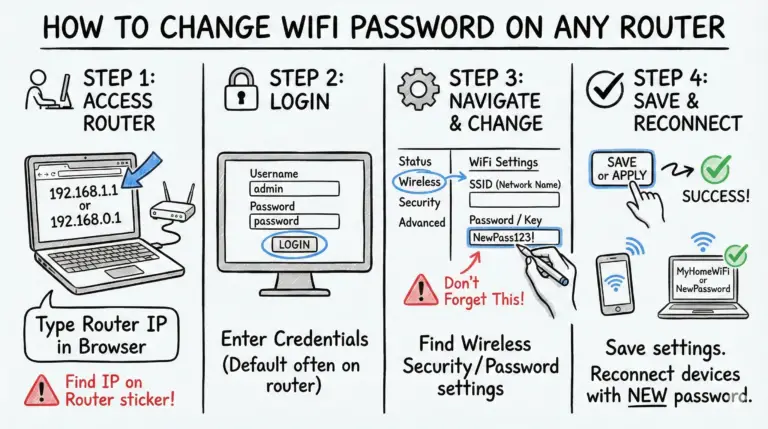Wi-Fi 7 is the newest version of Wi-Fi, bringing super-fast internet speeds up to 46 Gbps. It works on several channels, including 2.4 GHz, 5 GHz, 6 GHz, and possibly 7 GHz, making it better and faster. Features like Multi-Link Operation (MLO) and 4096-QAM modulation help it handle more devices with less delay. This means better internet for smart homes and gaming. Wi-Fi 7 also keeps your connection safe with WPA3 security.
In this article, we will discuss how this new technology is set to change the way we connect to the internet!
Key Takeaways
- WiFi 7 (802.11be) is the latest standard in Wireless Networking, offering speeds up to 46 Gbps, enhanced Bandwidth, and reduced Latency.
- It operates across multiple Frequency Bands, including the 2.4 GHz, 5 GHz, 6 GHz, and potentially 7 GHz bands.
- Key features include Multi-Link Operation (MLO), 4096-QAM modulation, enhanced OFDMA, and MU-MIMO supporting up to 16 spatial streams.
- WiFi 7 significantly enhances Network Performance, making it ideal for Smart Homes, Gaming, Enterprise Solutions, and Streaming Applications.
- Upgrading to WiFi 7 requires compatible hardware, including WiFi 7 Routers and devices, to fully leverage the new standard’s capabilities.
- WiFi 7 ensures robust security with WPA3, supports a higher number of simultaneous connections, and provides a solid foundation for future wireless innovations.
WiFi 5 vs. Wi-Fi 6 vs Wi-Fi 6e vs WiFi 7 Technology Comparison
| Feature | WiFi 5 (802.11ac) | WiFi 6 (802.11ax) | WiFi 6E (802.11ax) | WiFi 7 (802.11be) |
|---|---|---|---|---|
| Maximum Speed | Up to 3.5 Gbps | Up to 9.6 Gbps | Up to 9.6 Gbps | Up to 46 Gbps |
| Frequency Bands | 5 GHz | 2.4 GHz, 5 GHz | 2.4 GHz, 5 GHz, 6 GHz | 2.4 GHz, 5 GHz, 6 GHz, potentially 7 GHz |
| MU-MIMO | Yes (4 streams) | Yes (8 streams) | Yes (8 streams) | Yes (16 streams) |
| OFDMA | No | Yes | Yes | Enhanced OFDMA |
| Latency | Moderate | Low | Low | Very Low |
| Beamforming | Basic | Advanced | Advanced | Enhanced |
| Channel Bonding | Up to 160 MHz | Up to 160 MHz | Up to 160 MHz | Up to 320 MHz |
| Security Protocols | WPA2 | WPA3 | WPA3 | WPA3 |
| Compatibility | Backward compatible | Backward compatible | Backward compatible | Backward compatible |
The Evolution of Wi-Fi
Wireless Fidelity, or Wi-Fi, has revolutionized communication since its inception in 1997. The first generation, IEEE 802.11, offered speeds of only 2 Mbps, which, though groundbreaking at the time, is minuscule by today’s standards. Over the years, Wi-Fi has evolved through several iterations—Wi-Fi 4 (802.11n), Wi-Fi 5 (802.11ac), and Wi-Fi 6 (802.11ax)—each bringing significant improvements in speed, efficiency, and user capacity.
Wi-Fi 6, introduced in 2019, made significant strides in efficiency by leveraging MU-MIMO (multi-user, multiple-input, multiple-output) and OFDMA (orthogonal frequency-division multiple access) technologies. It enabled faster data transfer rates, improved network performance in crowded environments, and extended the battery life of connected devices. As remarkable as Wi-Fi 6 has been, the exponential rise in connected devices and data usage has created the need for even more robust wireless technology. Enter Wi-Fi 7, the next step in this continuous evolution.
What Is Wi-Fi 7?
Wi-Fi 7, also referred to as 802.11be, is the latest standard in wireless networking technology, anticipated to begin commercial deployment by 2024 or 2025. It has been developed with a singular goal in mind: to support the growing demand for ultra-fast, low-latency, and highly reliable wireless communication. Unlike incremental improvements seen in previous versions, Wi-Fi 7 introduces several groundbreaking features designed to meet future networking requirements.
At its core, Wi-Fi 7 focuses on three main areas: higher speeds, more efficient spectrum utilization, and reduced latency, which are essential for the best Wi-Fi experience. These innovations are aimed at providing a superior user experience on applications such as ultra-high-definition streaming, augmented reality (AR), virtual reality (VR), artificial intelligence (AI), and next-generation gaming, while also ensuring robust performance in highly congested environments like smart cities, stadiums, and office buildings.
Key Features of Wi-Fi 7
Multi-Link Operation (MLO)
A defining feature of Wi-Fi 7 is Multi-Link Operation (MLO). Previous Wi-Fi standards have allowed devices to connect through a single link, either on the 2.4 GHz, 5 GHz, or 6 GHz bands. MLO changes this by enabling Wi-Fi 7 devices to establish multiple simultaneous connections across different frequency bands, enhancing overall network efficiency.
Benefits of MLO:
- Enhanced connectivity and performance for Wi-Fi 7 devices, leading to superior user experiences.
- Improved reliability by using alternative paths when signal interference occurs on one band.
- Increased data speeds by aggregating multiple channels, essentially allowing devices to send and receive more data simultaneously.
- Reduced latency by dynamically switching between available links for the fastest connection.
320 MHz Channel Widths
Wi-Fi 7 doubles the channel width potential from Wi-Fi 6E’s 160 MHz to a staggering 320 MHz, meaning that data pipelines are now significantly wider and can support higher data rates. Wider channels allow more data to flow at any given time, drastically improving speeds.
Why This Matters:
- This feature is especially useful for bandwidth-intensive activities like 8K streaming and online gaming, ensuring smoother and uninterrupted data transmission.
- Wider channels reduce congestion since multiple devices can coexist on a single network without degrading performance.
4096-QAM Modulation
Wi-Fi 7 introduces improved modulation techniques, jumping from the 1024-QAM (Quadrature Amplitude Modulation) used in Wi-Fi 6 to 4096-QAM. This allows more data to be packed into each signal wave, increasing overall throughput.
Impact:
Higher modulation levels result in faster connection speeds, with Wi-Fi 7 offering theoretical peak speeds of up to 46 Gbps, compared to Wi-Fi 6’s 9.6 Gbps.
Improved Spatial Efficiency with MU-MIMO
Wi-Fi 7 upgrades MU-MIMO technology from 8 spatial streams to 12, enabling even greater multitasking capabilities. This allows networks to support many devices simultaneously without compromising speed or quality.
Enhanced Target Wake Time (TWT)
Wi-Fi 7 builds upon TWT, first introduced in Wi-Fi 6, improving power management for connected devices. TWT allows Wi-Fi 7 devices to “wake” only when they need to communicate, reducing power consumption for IoT devices and extending battery life.
Benefits of Wi-Fi 7
These technological advancements translate into tangible benefits that will transform your digital life:
- Blazing-Fast Speeds: Wi-Fi 7’s multi-gigabit speeds unlock a world of possibilities, from seamless 8K streaming and lag-free gaming to lightning-fast file transfers and smooth video conferencing.
- Ultra-Low Latency: With MLO and wider channels, Wi-Fi 7 delivers near-instantaneous communication, crucial for applications like VR gaming, augmented reality experiences, and real-time collaboration.
- Increased Device Density: Enhanced MU-MIMO and wider channels empower Wi-Fi 7 networks to support a multitude of devices without breaking a sweat. This is essential for smart homes, busy offices, and crowded public spaces.
- Future-Ready Connectivity: Wi-Fi 7 is designed to handle the wireless demands of tomorrow, from immersive AR/VR experiences to the ever-expanding Internet of Things (IoT).
- Enhanced Energy Efficiency: Improved TWT technology ensures that your IoT devices, wearables, and other battery-powered gadgets can last longer between charges.
Applications of Wi-Fi 7
- Smart Homes and IoT: Wi-Fi 7 will provide seamless connectivity for smart home ecosystems, enabling faster communication between devices like smart TVs, speakers, thermostats, and security systems.
- Immersive AR/VR Experiences: Virtual and augmented reality applications will greatly benefit from the low latency and high data transfer rates of Wi-Fi 7, making experiences more realistic and responsive.
- Healthcare: Medical facilities can leverage Wi-Fi 7’s capabilities for telemedicine, real-time imaging, and connected devices in intensive care units with high reliability.
- Industry and Automation: Wi-Fi 7 is poised to support industrial automation, warehouses, and robotics, enabling the smooth operation of machines, sensors, and AI-driven processes.
- Smart Cities:With its increased capacity and reduced congestion, Wi-Fi 7 can form the backbone of smart city communication, powering everything from traffic systems to public Wi-Fi networks.
Challenges and Considerations of WiFi 7
Despite its promise, Wi-Fi 7 faces several challenges:
- Cost of Adoption: As with any new technology, the infrastructure and devices required for Wi-Fi 7 are expected to be expensive in the initial phases, potentially slowing its adoption.
- Compatibility Issues: Older devices may not be compatible with Wi-Fi 7 networks, creating a potential gap between current and future technologies.
- Regulatory Hurdles: The widespread adoption of the 6 GHz spectrum, crucial for Wi-Fi 7, will depend on regulatory clearances in various regions.
- Technological Complexity: Wi-Fi 7’s advanced features might increase network complexity, requiring better management tools and technical expertise.
- Security Concerns: As with any innovation, new capabilities might also open new vulnerabilities, necessitating robust security measures to protect networks and data.
When Will WiFi 7 Be Available?
WiFi 7 has officially launched, but its availability is rolling out in phases:
Current Status: The Wi-Fi Alliance introduced its “Wi-Fi CERTIFIED 7” program on January 8, 2024. While devices can now receive official certification, the final IEEE standard ratification is expected by the end of 2024-25
Device Availability
- WiFi 7 routers from manufacturers like TP-Link, Netgear, and ASUS are already in the market
- The TP-Link Archer BE800 starts at $300, while premium models can cost over $1,000
- Intel’s BE200 WiFi 7 card is appearing in some new laptops
Market Adoption Timeline
Expected Growth:
- 233 million WiFi 7 devices will enter the market in 2024-25
- Growth to 2.1 billion devices by 2028
Early Adopters:
- Smartphones
- PCs and laptops
- Tablets
- Access points
Practical Considerations
While WiFi 7 hardware is becoming available, widespread adoption faces some practical limitations:
- Most US homes currently average around 200Mbps internet speeds
- Full benefits require both WiFi 7 routers and compatible devices
- Operating system support for key features like MLO is still in development
The Future of Wireless Connectivity: What Lies Ahead?
Wi-Fi 7 is not the end of the wireless journey; it’s a stepping stone to even greater innovations. We can anticipate further advancements in spectrum management, antenna design, and integration with emerging technologies like edge computing and artificial intelligence.
As Wi-Fi 7 becomes more prevalent, it will reshape the wireless landscape, fostering innovation in smart homes, healthcare, enterprise solutions, and beyond. It will seamlessly integrate with other wireless technologies like 5G, Bluetooth, and Zigbee, creating a cohesive and comprehensive connectivity ecosystem.
Conclusion: Embracing the Wi-Fi 7 Revolution
Wi-Fi 7 is more than just a technology upgrade; it’s a gateway to a future where connectivity is faster, more reliable, and more efficient than ever before. Whether you’re a gamer seeking lag-free experiences, a homeowner building a smart haven, or a business leader looking to empower your workforce, Wi-Fi 7 offers the tools to thrive in the digital age.
By embracing Wi-Fi 7, you’re not just adopting a new standard; you’re investing in a future where the possibilities are limitless.
Frequently Asked Questions
Will my current devices work with Wi-Fi 7 routers?
Yes, Wi-Fi 7 routers are backward compatible with previous Wi-Fi standards, though older devices won’t benefit from Wi-Fi 7’s advanced features.
How does Wi-Fi 7 handle interference?
Wi-Fi 7 uses advanced features like Multi-Link Operation and Preamble Puncturing to actively avoid and mitigate interference, resulting in more stable connections.
Is Wi-Fi 7 more energy-efficient than previous standards?
A: Yes, Wi-Fi 7 includes enhanced power-saving features like Target Wake Time (TWT) and improved signal processing, which can help extend device battery life.
What kind of real-world speeds can I expect from Wi-Fi 7?
A: While theoretical maximum speeds reach 46 Gbps, real-world speeds will typically be lower but still significantly faster than Wi-Fi 6, consistently delivering multi-gigabit speeds under optimal conditions.
- How to Configure a Secure Site-to-Site VPN on Cisco Firepower Complete Guide - December 3, 2025
- Jobs for Network Engineers: Roles, Skills & Pay - December 3, 2025
- How to Change WiFi Password on Any Router : The Last Guide You Need - December 1, 2025




